
Here you can study for the exam. Look up keywords and learn definitions about all kind of subjects.
More subjects
The Toyota Land Cruiser (Japanese: トヨタ・ランドクルーザー, Hepburn: Toyota Rando-Kurūzā) (also sometimes spelled as LandCruiser) is a series of four-wheel drive vehicles produced by the Japanese automobile manufacturer Toyota. It is Toyota's longest running series of models. As of 2019, the sales of the Land Cruiser totalled more than 10 million units worldwide. Production of the first generation of the Land Cruiser began in 1951. The Land Cruiser has been produced in convertible, hardtop, station wagon and cab chassis body styles. The Land Cruiser's reliability and longevity have led to huge popularity, especially in Australia, where it is the best-selling body-on-frame, four-wheel drive vehicle. Toyota also extensively tests the Land Cruiser in the Australian outback – considered to be one of the toughest operating environments in both temperature and terrain. In Japan, the Land Cruiser was once exclusive to Toyota Japanese dealerships called Toyota Store. (Source: Wikipedia.org, CC BY-SA)
The Toyota MR2 is a line of two-seat, mid-engined, rear-wheel-drive sports cars manufactured in Japan and marketed globally by Toyota from 1984 until 2007 over three generations: W10 (1984–1989), W20 (1989–1999) and W30 (1999–2007). It is Japan's first rear mid-engined production car. Conceived as a small, economical and sporty car, the MR2 employed straightforward design elements, including fully independent MacPherson strut front and rear suspensions, four-wheel disc brakes, and a transverse-mounted inline-four engine. The name MR2 stands for either 'mid-ship run-about 2-seater' or 'mid-engine, rear-wheel-drive, 2-seater'. In French-speaking markets, the vehicle was renamed Toyota MR because the abbreviation 'MR2' sounds like the profanity 'merde' when spoken in French. (Source: Wikipedia.org, CC BY-SA)
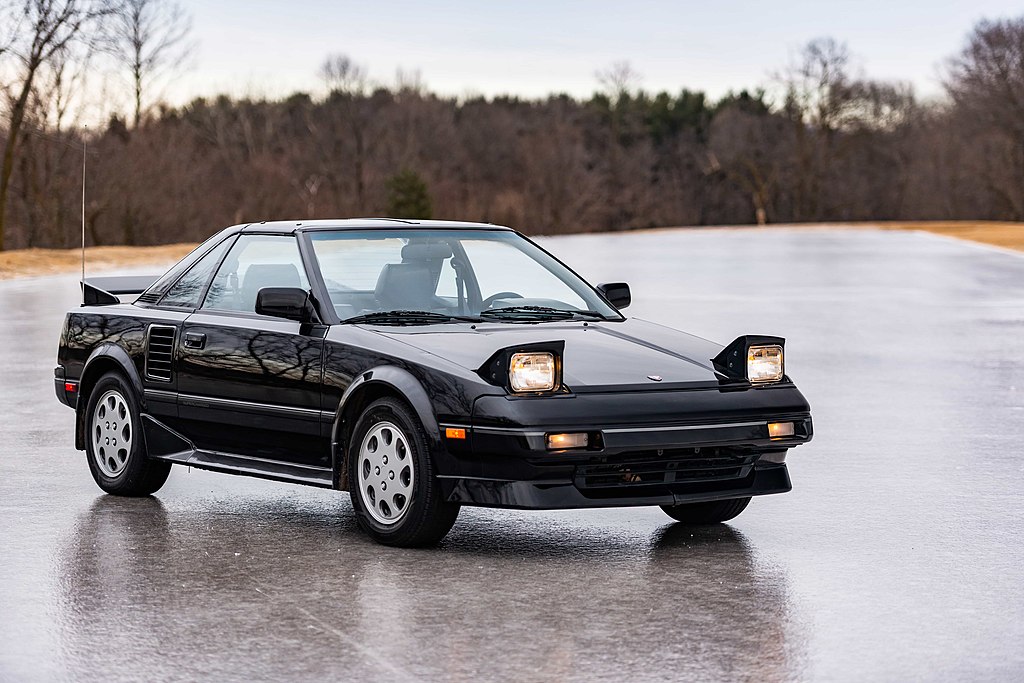 © Wikimedia.org/ 4AGZE, CC BY-SA
© Wikimedia.org/ 4AGZE, CC BY-SA
The Toyota Mark II (Japanese: トヨタ・マークII, Hepburn: Toyota Māku Tsū) is a compact, later mid-size sedan manufactured and marketed in Japan by Toyota between 1968 and 2004. Prior to 1972, the model was marketed as the Toyota Corona Mark II. In some export markets, Toyota marketed the vehicle as the Toyota Cressida between 1976 and 1992 across four generations. Toyota replaced the rear-wheel-drive Cressida in North America with the front-wheel-drive Avalon. Every Mark II and Cressida was manufactured at the Motomachi plant at Toyota, Aichi, Japan from September 1968 to October 1993, and later at Toyota Motor Kyushu's Miyata plant from December 1992 to October 2000, with some models also assembled in Jakarta, Indonesia as the Cressida. (Source: Wikipedia.org, CC BY-SA)
The Toyota Matrix, officially referred to as the Toyota Corolla Matrix, is a compact hatchback manufactured by Toyota Motor Manufacturing Canada in Cambridge, Ontario and derived from the Corolla. Introduced in 2002 as a 2003 model, the Matrix was the result of a joint venture between Toyota and General Motors, with the GM version being the Pontiac Vibe, which was assembled by New United Motor Manufacturing, Inc. (NUMMI) in Fremont, California, United States. The Matrix was positioned as a sporty hatchback counterpart of the North American Corolla and was counted as a variant of it in Toyota's sales figures. Although identical mechanically, and nearly as much internally, the Matrix and Vibe had different sheetmetal and exterior trim designed by their respective brands. Both vehicles are narrow, tall station wagons styled in a quasi-SUV fashion (called a crossover utility vehicle or 'CUV' by Toyota) and marketed to a fairly youthful market segment. (Source: Wikipedia.org, CC BY-SA)
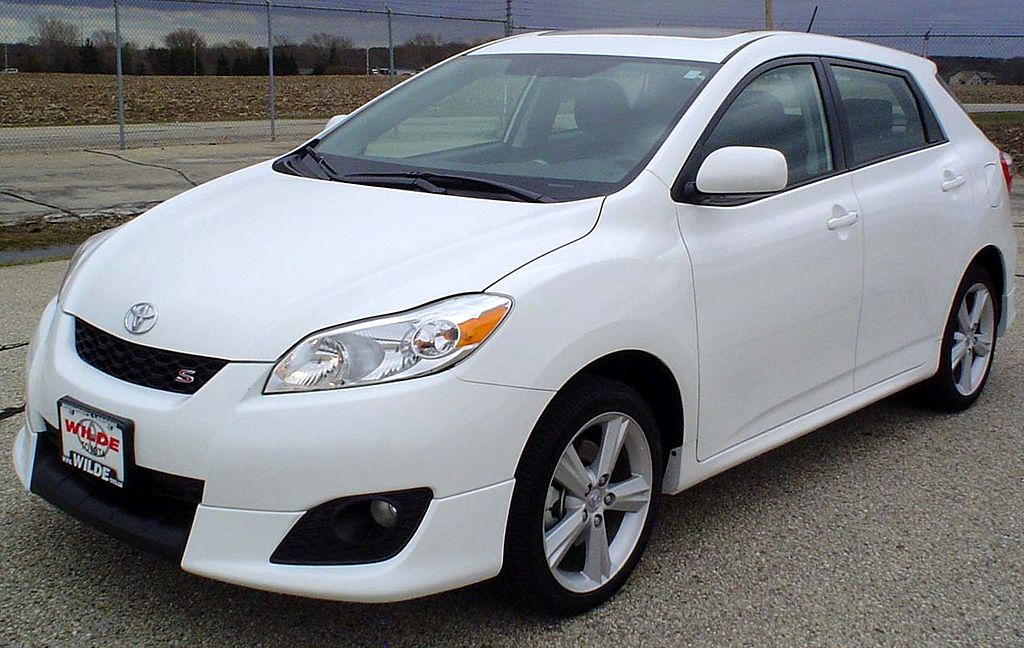 © Wikimedia.org/U.S. National Highway Traffic Safety Administration, CC0
© Wikimedia.org/U.S. National Highway Traffic Safety Administration, CC0
The Toyota Mirai (Japanese: トヨタ・MIRAI, Hepburn: Toyota Mirai) (from mirai (未来), Japanese for 'future') is a mid-size hydrogen fuel cell vehicle (FCV) manufactured by Toyota, and is the first FCV automobiles to be mass-produced and sold commercially. The Mirai was unveiled at the November 2014 Los Angeles Auto Show. As of November 2022, global sales totaled 21,475 units; the top-selling markets were the U.S. with 11,368 units, Japan with 7,435 and the rest of the world with 2,622. Under the U.S. Environmental Protection Agency (EPA) cycle, the 2016 model year Mirai has a total range of 502 km (312 mi) on a full tank. The MPG-equivalent combined city/highway fuel economy rating was 66 mpg‑US (3.6 L/100 km; 79 mpg‑imp), making the Mirai the most fuel-efficient hydrogen fuel cell vehicle rated at the time by the EPA, and the one with the longest range. In August 2021, the second-generation Mirai set a world record of traveling 1,360 km (845 mi) with a full tank of 5.65 kg hydrogen. (Source: Wikipedia.org, CC BY-SA)
The Toyota Paseo (known as the Toyota Cynos (Japanese: トヨタ・サイノス, Toyota Sainosu) in Japan and other regions) is a sports-styled subcompact car sold from 1991 until 1999 by Toyota and was directly based on the Tercel. It was available as a coupé and in later models as a convertible. Toyota stopped selling the car in the United States in 1997, however the car continued to be sold in Canada, Europe and Japan until 1999. The Paseo, like the Tercel, shares a platform with the Starlet. Several parts are interchangeable between the three. The name 'Paseo' is Spanish for 'a walk' or 'a stroll', while the name 'Cynos' is a coined word taken from 'cynosure', meaning 'the target of attention'. In Japan it was exclusive to Toyopet Store locations. (Source: Wikipedia.org, CC BY-SA)
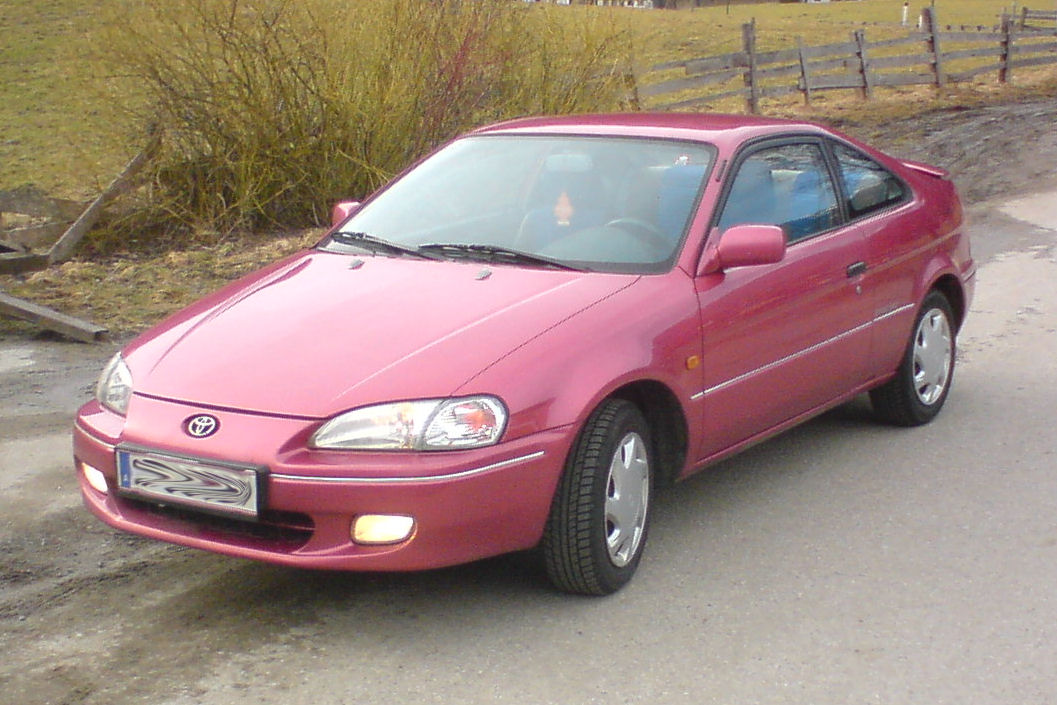 © Wikimedia.org/Hans0024, CC0
© Wikimedia.org/Hans0024, CC0
The Toyota Prius (/ˈpriːəs/) (Japanese: トヨタ・プリウス, Hepburn: Toyota Puriusu) is a mid-size car (compact in Northern American markets) built by Toyota which has a hybrid drivetrain, combining an internal combustion engine with an electric motor. Initially offered as a four-door sedan, it has been produced only as a five-door liftback since 2003. In 2007, the United States Environmental Protection Agency (EPA) and California Air Resources Board (CARB) rated the Prius as among the cleanest vehicles sold in the United States on the basis of smog-forming emissions. The 2018 model year Prius Eco ranked as the second-most-fuel-efficient gasoline-powered car without plug-in capability available in the US that year, following the Hyundai Ioniq Blue hybrid. (Source: Wikipedia.org, CC BY-SA)
The Toyota RAV4 (Japanese: トヨタ・RAV4, Hepburn: Toyota Ravufō) is a compact crossover SUV produced by the Japanese automobile manufacturer Toyota. Considered the first ever compact crossover SUV, it made its debut in Japan and Europe in 1994, and in North America in 1995, being launched in January 1996. The vehicle was designed for consumers wanting a vehicle that had most of the benefits of SUVs, such as increased cargo room, higher visibility, and the option of full-time four-wheel drive, along with the manoeuvrability and fuel economy of a compact car. The vehicle's name is an abbreviation of 'Recreational Active Vehicle with 4-wheel drive', or 'Robust Accurate Vehicle with 4-wheel drive', although not all models come equipped with the four-wheel drive system. (Source: Wikipedia.org, CC BY-SA)
The Toyota Sequoia is a full-size SUV manufactured by Toyota mainly for the North American market since 2000 for the 2001 model year and derived from the Tundra pickup truck. It is the second largest SUV ever produced under the Toyota brand, after the Japan-exclusive, military-focused Mega Cruiser. Previously manufactured at Toyota Motor Manufacturing Indiana in Princeton, Indiana between 2000 and 2021, and then in Toyota Motor Manufacturing Texas in San Antonio, Texas since 2022, the Sequoia is the first vehicle from a Japanese marque in the popular mainstream full-sized SUV class in North America, and initial planning done by first-generation Sequoia chief engineer Kaoru Hosokawa aimed the Sequoia directly at the Ford Expedition, Chevrolet Tahoe, Nissan Armada, and other full-size SUVs. (Source: Wikipedia.org, CC BY-SA)
The Toyota Sienna is a minivan manufactured and marketed by Toyota primarily for the North American market. It is named for the Italian city of Siena, in the region of Tuscany. It replaced the first generation Previa van in 1997 with a more conventional front-wheel drive layout and shares a heavily revised platform with the Camry. Both the Previa and original Sienna were smaller than the other minivans they competed against, but a redesign in 2003 (for the 2004 model year) increased the dimensions to match those of its competitors. It was redesigned again in 2010 (for the 2011 model year). The third generation Sienna went on sale in the United States in February 2010 and is the first Sienna to ever receive a 'Top Safety Pick' award from the Insurance Institute for Highway Safety. A 2020 redesign (for the 2021 model year) saw the Sienna becoming a hybrid vehicle for its fourth generation. While previous generations of the Sienna were exported to select Asian and European markets, the fourth generation is the first to be produced outside of the United States as Chinese production commenced in July 2021 by two Toyota joint ventures. In China, it is also marketed as the Toyota Granvia. (Source: Wikipedia.org, CC BY-SA)
The Toyota Soarer (Japanese: トヨタ・ソアラ, Hepburn: Toyota Soara) is a personal luxury GT coupé produced from 1981 to 2005 by Toyota and sold in Japan. It was available at both Japanese Toyota dealerships called Toyota Store and Toyopet Store, and it debuted with the Z10 series, replacing the Toyopet Store exclusive Mark II coupé, and the Toyota Store exclusive Crown coupé. In 1986, the Z20 series Soarer was launched, based on the then new A70 series Supra platform. In 1991, the Z30 series Soarer premiered in Japan, while its Lexus equivalent, the SC 300/400 debuted in the US market. (Source: Wikipedia.org, CC BY-SA)
The Toyota Sports 800 (Japanese: トヨタ・スポーツ800, Toyota Supōtsu Happiyaku) is Toyota's first production sports car. The prototype for the Sports 800, called the Publica Sports, debuted at the 1962 Tokyo Auto Show, featuring a space age sliding canopy and utilizing the 21 kW (28 hp; 29 PS) powertrain of the Publica 700, a Japanese market economy car. The Toyota Sports 800 is affectionately called the 'Yota-Hachi' (ヨタハチ), which is a Japanese short form for 'Toyota 8'. In Japan, the vehicle was exclusive to Toyota Japan retail sales channel called Toyota Publica Store alongside the Publica. (Source: Wikipedia.org, CC BY-SA)
The Toyota Supra (Japanese: トヨタ・スープラ, Hepburn: Toyota Sūpura) is a sports car and grand tourer manufactured by the Toyota Motor Corporation beginning in 1978. The name 'supra' is derived from the Latin prefix, meaning 'above', 'to surpass' or 'go beyond'. The initial four generations of the Supra were produced from 1978 to 2002. The fifth generation has been produced since March 2019 and went on sale in May 2019. The styling of the original Supra was derived from the Toyota Celica, but it was both longer and wider. Starting in mid-1986, the A70 Supra became a separate model from the Celica. In turn, Toyota also stopped using the prefix Celica and named the car Supra. Owing to the similarity and past of the Celica's name, it is frequently mistaken for the Supra, and vice versa. The first, second and third generations of the Supra were assembled at the Tahara plant in Tahara, Aichi, while the fourth generation was assembled at the Motomachi plant in Toyota City. The 5th generation of the Supra is assembled alongside the G29 BMW Z4 in Graz, Austria by Magna Steyr. (Source: Wikipedia.org, CC BY-SA)
The Toyota T100 is a full-size pickup truck produced by Toyota between 1992 and 1998. It was developed strictly for the US (and Canadian) markets, where larger pickups have a sizable market share. As Toyota firmly established itself in the North American compact pickup truck market in the 1980s through 1990s, the company decided to offer a truck that was larger than the compact so as to offer an alternative to the traditional North American full-size pickup truck market. North American Toyota dealers had long been clamoring for a full-sized Toyota truck, especially in light of the high percentage of Toyota Pickup owners who moved on to domestic full-sized trucks. The T100 reflected a philosophy of designing products specifically for localized international markets, where traditional products sold and made in Japan wouldn't sell well. This approach is also demonstrated with the introduction of the mid-size Toyota Camry (XV10) which was larger than the compact Toyota Camry (V30) in 1991, and again in 1997 when the Toyota Sienna replaced the slow selling Toyota Previa. (Source: Wikipedia.org, CC BY-SA)
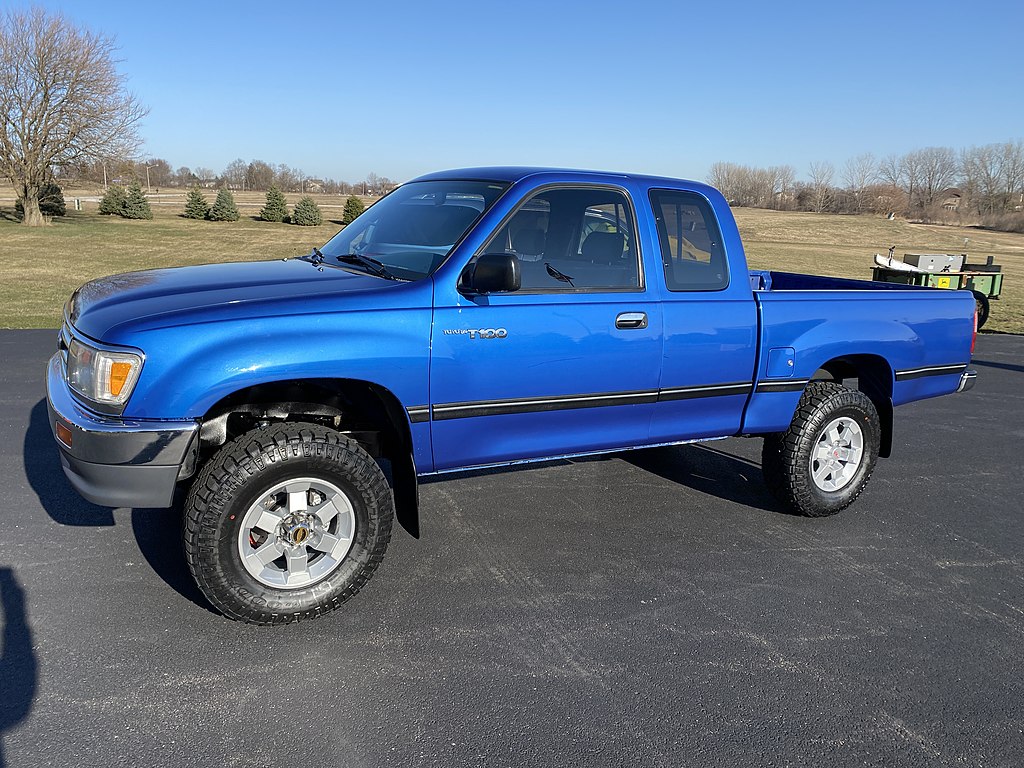 © Wikimedia.org/Walldo123, CC BY-SA
© Wikimedia.org/Walldo123, CC BY-SA
The Toyota Tacoma is a pickup truck manufactured by the Japanese automobile manufacturer Toyota since 1995. The first-generation Tacoma (model years 1995 through 2004) was classified as a compact pickup. The second generation (model years 2005 through 2015) and third generation (in production since 2015) models are classified as mid-sized pickups. The Tacoma was Motor Trend's Truck of the Year for 2005. As of 2015, the Tacoma was sold in the United States, Canada, Mexico, Costa Rica, Bolivia, Bermuda, and the French overseas collectivity of New Caledonia. Most markets across the world receive the Toyota Hilux in lieu of the Tacoma. The name 'Tacoma' was derived from the Coast Salish peoples' name for Mount Rainier in the U.S. state of Washington. (Source: Wikipedia.org, CC BY-SA)
The Toyota Tercel (Japanese: トヨタ・ターセル, Toyota Tāseru) is a subcompact car manufactured by Toyota from 1978 until 1999 across five generations, in five body configurations sized between the Corolla and the Starlet. Manufactured at the Takaoka plant in Toyota City, Japan, and sharing its platform with the Cynos (aka Paseo) and the Starlet, the Tercel was marketed variously as the Toyota Corolla II (Japanese: トヨタ・カローラII, Toyota Karōra II) — sold at Toyota Japanese dealerships called Toyota Corolla Stores — and was replaced by the Platz in 1999. It was also known as the Toyota Corsa (Japanese: トヨタ・コルサ, Toyota Korusa) and sold at Toyopet Store locations. Starting with the second generation, the Tercel dealership network was changed to Vista Store, as its badge engineered sibling, the Corolla II, was exclusive to Corolla Store locations. (Source: Wikipedia.org, CC BY-SA)
The Toyota Tundra is a pickup truck manufactured in the United States by the Japanese manufacturer Toyota since May 1999. The Tundra was the second full-size pickup to be built by a Japanese manufacturer (the first was the Toyota T100), but the Tundra was the first full-size pickup from a Japanese manufacturer to be built in North America. The Tundra was nominated for the North American Truck of the Year award and was Motor Trend magazine's Truck of the Year in 2000 and 2008. Initially built in a new Toyota plant in Princeton, Indiana, production was consolidated in 2008 to Toyota's San Antonio, Texas, factory and is the only full-size pickup truck manufactured in Texas. (Source: Wikipedia.org, CC BY-SA)
The Toyota Venza is a five-passenger mid-size crossover SUV manufactured and marketed by Toyota primarily for the North American market. The first-generation model was based on the XV40 series Camry platform and sold between 2008 and 2017. It also shared the platform with the AL10 series Lexus RX. The second-generation model is a rebadged Japanese-market XU80 series Harrier and has been sold since September 2020. The name 'Venza' is a mix of 'Venture' and 'Monza.' The first-generation Venza was unveiled at the 2008 North American International Auto Show in Detroit. It was designed at the Calty Design studios in Newport Beach, California, based on the FT-SX concept car and primarily engineered[citation needed] at Toyota Technical Center in Ann Arbor, Michigan. Venza's production began at Toyota Motor Manufacturing Kentucky (TMMK) in Georgetown, Kentucky in November 2008. The 2.7 L model was launched in February 2009. (Source: Wikipedia.org, CC BY-SA)
The Toyota Yaris (Japanese: トヨタ・ヤリス, Hepburn: Toyota Yarisu) is a supermini/subcompact car sold by Toyota since 1999, replacing the Starlet and Tercel. Up to 2019, Toyota had used the Yaris nameplate on export versions of various Japanese-market models, with some markets receiving the same vehicles under the Toyota Echo name through 2005. Starting in 2020, the Yaris nameplate began to be used in Japan, which replaced the Vitz nameplate. The Yaris nameplate has also been applied to other vehicles. From 1999 to 2005, the nameplate had been used for the Yaris Verso mini MPV sold in Europe, where it was known in Japan as the FunCargo. Since 2020, the nameplate has also been used for the subcompact crossover SUV offering called Yaris Cross. In North America, most Yaris sedan models sold from 2015 to 2020 and Yaris hatchbacks sold from 2019 until 2020 were restyled versions of the Mazda2, produced and developed by Mazda. (Source: Wikipedia.org, CC BY-SA)
The Vauxhall Viva is a small family car that was produced by Vauxhall in a succession of three versions between 1963 and 1979. These were designated the HA, HB and HC series. The Viva was introduced a year after Vauxhall's fellow GM company Opel launched the Opel Kadett A. Both cars were a result of the same General Motors project and share the same floorpan and engine constructions, but with one main difference being the use of metric measurements for the Opel and imperial ones for the Vauxhall. They are also visually similar, however few components are interchangeable and the cars are thus not 'sister models' or versions of one another. - as Opel and Vauxhall vehicles would become from the mid 1970s onward. A van version was also produced, as the Bedford HA. In the UK the Viva's principal competitors at the time of its launch included the well-established Ford Anglia and Morris Minor. (Source: Wikipedia.org, CC BY-SA)
The Vector W8 is a sports car produced by American automobile manufacturer Vector Aeromotive Corporation from 1989 to 1993. It was designed by company founder and chief designer Gerald Wiegert while receiving refinements by Vector's head of engineering David Kostka. The W8 was the production version of the Vector W2 prototype that the company demonstrated throughout the 1980s. Vector claimed the W8 could reach a projected top speed of 242 mph (389 km/h), with acceleration from 0–60 mph (0–97 km/h) achievable in a time of 3.9 seconds. According to the published tests of the W8 by Road & Track in its March 1991 and August 1992 issues, the W8 recorded a 0–60 mph acceleration time of 4.2 seconds. Despite not conducting a top speed test, Road & Track provided an estimated 218 mph (351 km/h) top speed based on the redline RPM of the W8's top gear in its 3-speed automatic transmission. (Source: Wikipedia.org, CC BY-SA)
The Volkswagen Beetle—officially the Volkswagen Type 1, informally in German der Käfer (meaning 'beetle'), in parts of the English-speaking world the Bug, and known by many other nicknames in other languages—is a two-door, rear-engine economy car, intended for five occupants (later, Beetles were restricted to four people in some countries), that was manufactured and marketed by German automaker Volkswagen (VW) from 1938 until 2003. The need for a people's car (Volkswagen in German), its concept and its functional objectives were formulated by the leader of Nazi Germany, Adolf Hitler, who wanted a cheap, simple car to be mass-produced for his country's new road network (Reichsautobahn). Members of the National Socialist party, with an additional dues surcharge, were promised the first production, but the Spanish Civil War shifted most production resources to military vehicles to support the Nationalists under Francisco Franco. (Source: Wikipedia.org, CC BY-SA)
The Volkswagen Corrado is a compact four passenger (2+2), three door, front-engine, front-wheel-drive liftback coupe marketed by Volkswagen from 1988 until 1995, and manufactured by Karmann in Osnabrück, Germany. Designed by Herbert Schäfer, the Corrado overlapped and eventually superseded Volkswagen's Scirocco model. 97,521 Corrados were manufactured over the seven year production run. The Corrado's floorpan is based on the A2 platform (i.e. Mark 2 Golf/Jetta) and, with the exception of VR6 models, all versions use the subframes, suspension, steering and braking components from the Volkswagen A2 platform model range. (Source: Wikipedia.org, CC BY-SA)
The Volkswagen Eos was a sport compact cabriolet coupé produced by the German automaker Volkswagen from 2006 to 2015. Assembled at AutoEuropa in Portugal, it was a convertible only compact coupé introduced as the successor of the Volkswagen Golf Cabriolet. It was Volkswagen's first production coupé since the Volkswagen Corrado, which ended production in July 1995. The name Eos was derived from Eos, the Greek goddess of the dawn. The Eos ended production in May 2015. However, a limited number of base trim models were sold as models of 2016 in the United States. (Source: Wikipedia.org, CC BY-SA)
The Volkswagen Gol is a subcompact car that has been manufactured by Volkswagen do Brasil since 1980 as Volkswagen's entry-level car in the Latin American market—where it succeeded the Volkswagen Type 1 (Fusca) and the Volkswagen Brasilia. Several variants of the Gol-drived Voyage and Parati were marketed in North America as the Volkswagen Fox from 1987 to 1993. The Gol has been produced in several versions, such as three- and five-door hatchbacks, four-door sedans (the Volkswagen Voyage), three- and five-door station wagons (the Volkswagen Parati), and two-door coupé utilities (the Volkswagen Saveiro). The Gol was the best-selling car in Brazil for 27 consecutive years, from 1987 to 2014, and has been the most popular car in Argentina since 1988; approximately five million Gols have been manufactured in South America since 1980. In March 2013 it was announced that cumulative production of the Gol and its derivatives (Voyage, Saveiro, Parati) had reached 10 million units. It takes its name from the Portuguese (and Spanish) word for goal in football, taking advantage of the Brazilians' passion for football. (Source: Wikipedia.org, CC BY-SA)
The Volkswagen Golf (listen (help·info)) is a compact car/small family car (C-segment) produced by the German automotive manufacturer Volkswagen since 1974, marketed worldwide across eight generations, in various body configurations and under various nameplates – including as the Volkswagen Rabbit in the United States and Canada (Mk1 and Mk5), and as the Volkswagen Caribe in Mexico (Mk1). The original Golf Mk1 was a front-engined, front-wheel drive replacement for the air-cooled, rear-engined, rear-wheel drive Volkswagen Beetle. Historically, the Golf is Volkswagen's best-selling model and is among the world's top three best-selling models, with more than 35 million units sold as of 2019. (Source: Wikipedia.org, CC BY-SA)
The Volkswagen Jetta (listen (help·info)) is a compact car/small family car manufactured and marketed by Volkswagen since 1979. Positioned to fill a sedan niche above the firm's Golf hatchback, it has been marketed over seven generations, variously as the Atlantic, Vento, Bora, City Jetta, Jetta City, GLI, Jetta, Clasico, and Sagitar (in China). The Jetta has been offered in two- and four-door saloon / sedan, and five-door wagon / estate versions – all as four- or five-seaters. Since the original version in 1980, the car has grown in size and power with each generation. By mid-2011, almost 10 million Jettas have been produced and sold all over the world. As of April 2014, Volkswagen marketed over 14 million, becoming its top selling model. (Source: Wikipedia.org, CC BY-SA)
The Volkswagen Passat is a series of large family cars manufactured and marketed by the German automobile manufacturer Volkswagen since 1973, and now in its eighth generation. It has been marketed variously as the Dasher, Santana, Quantum, Magotan, Corsar and Carat. The successive generations of the Passat carry the Volkswagen internal designations B1, B2, etc. A 'four-door coupé' variant of the Passat was released in the North American market in 2008 as the Passat CC, which was then renamed to Volkswagen CC. (Source: Wikipedia.org, CC BY-SA)
The Volkswagen Phaeton ( /ˈfeɪtən/ FAY-tən) (Typ 3D) is a full-size luxury sedan/saloon manufactured by the German automobile manufacturer Volkswagen, described by Volkswagen as their 'premium class' vehicle. Introduced at the 2002 Geneva Motor Show, the Phaeton was marketed worldwide. Sales in North America ended in 2006 and global sales ended in 2016. The name Phaeton derives from Phaëton, the son of Phoebus (or Helios) in Greek mythology, by way of the phaeton auto body style and the type of horse-drawn carriage that preceded it. Production ended in March 2016 and an all-electric second generation was slated to be produced. Starting in April 2017, the Gläserne Manufaktur Dresden assembles the e-Golf instead. (Source: Wikipedia.org, CC BY-SA)
The Volkswagen Scirocco is a three-door, front-engine, front-wheel-drive, sport compact hatchback manufactured and marketed by Volkswagen in two generations from 1974 to 1992 and a third generation from 2008 until 2017. Production ended without a successor. The Scirocco derives its name from the Mediterranean wind. Volkswagen began work on the car during the early 1970s as the replacement for the aging Karmann Ghia coupe, and designated it the Typ 53 internally. Although the platform of the Golf was used to underpin the new Scirocco, almost every part of the car was re-engineered in favour of a new styling (penned by Giorgetto Giugiaro) which was sleeker and sportier than that of the Golf. The Scirocco debuted at the 1973 Geneva Motor Show. (Source: Wikipedia.org, CC BY-SA)
The Volkswagen Tiguan (German pronunciation: [ˈfɔlksˌvaːgŋ̍ ˈtiːɡu̯aːn]) is a car produced by German manufacturer Volkswagen since 2007, sitting between the smaller T-Roc and the larger Touareg in the company's crossover SUV range. The first generation is based on the PQ46 platform, while the second generation, released in 2016, utilizes the Volkswagen Group MQB A2 platform. It is generally considered to be a medium-sized SUV in Europe, while in North America it is considered to be a compact crossover. The name Tiguan is a portmanteau of the German words Tiger ('tiger') and Leguan ('iguana') and won a naming contest by German car magazine publisher Auto Bild—from a field of names that also included Namib, Rockton, Samun and Nanuk. (Source: Wikipedia.org, CC BY-SA)
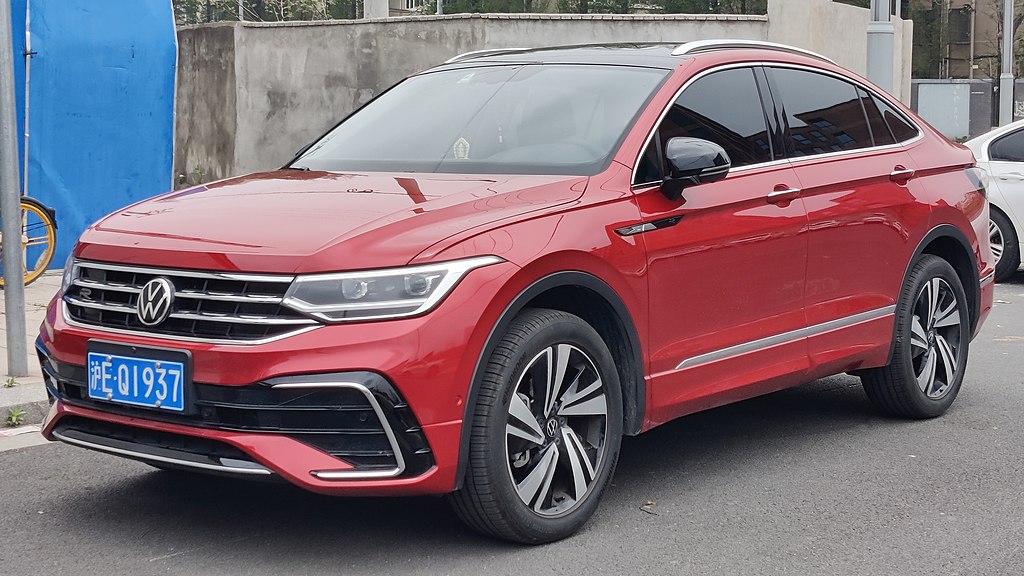 © Wikimedia.org/Zotyefan, CC BY-SA
© Wikimedia.org/Zotyefan, CC BY-SA
The Volkswagen Touareg (German pronunciation: [ˈtuːaʁɛk]) is a car produced by German automaker Volkswagen Group since 2002 at the Volkswagen Bratislava Plant. A five-seater mid-size luxury crossover SUV, the vehicle was named after the nomadic Tuareg people, inhabitants of the Saharan interior in North Africa. As of its first generation, the Touareg was developed together with the Porsche Cayenne and the Audi Q7, and as of October 2020, the Touareg was developed together with the Audi Q8, the Bentley Bentayga and the Lamborghini Urus. The vehicles were designed as unibody SUVs with independent suspensions. The initial generation (2002–2010) offered five-, six-, eight-, ten- and twelve-cylinder engine choices depending on choice. (Source: Wikipedia.org, CC BY-SA)
The Volkswagen Transporter, based on the Volkswagen Group's T platform, now in its seventh generation, refers to a series of vans produced for over 70 years and marketed worldwide. The T series is now considered an official Volkswagen Group automotive platform. and generations are sequentially named T1, T2, T3, T4, T5, T6 and T7. Pre-dating the T platform designations, the first three generations were named Type 2, indicating their relative position to the Type 1, or Beetle. As part of the T platform, the first three generations are retroactively named T1, T2 and T3. The Transporter is the best-selling van in history with over 12 million units sold worldwide, and it comprises a gamut of variants including vans, minivans, minibuses, pick-ups and campervans. Competitors include the Ford Transit, Toyota HiAce and Mercedes-Benz Vito. (Source: Wikipedia.org, CC BY-SA)
The Volkswagen Type 2, known officially (depending on body type) as the Transporter, Kombi or Microbus, or, informally, as the Bus (US), Camper (UK) or Bulli (Germany), is a forward control light commercial vehicle introduced in 1950 by the German automaker Volkswagen as its second car model. Following – and initially deriving from – Volkswagen's first model, the Type 1 (Beetle), it was given the factory designation Type 2. As one of the forerunners of the modern cargo and passenger vans, the Type 2 gave rise to forward control competitors in the United States in the 1960s, including the Ford Econoline, the Dodge A100, and the Chevrolet Corvair 95 Corvan, the latter adapting the rear-engine configuration of the Corvair car in the same manner in which the VW Type 2 adapted the Type 1 layout. (Source: Wikipedia.org, CC BY-SA)
The Volvo 140 Series is a line of mid-size cars manufactured and marketed by Volvo from 1966 to 1974 in two- and four-door sedan (models 142 and 144 respectively) as well as five door station wagon (model 145) body styles—with numerous intermediate facelifts. More than a million Volvo 140s were built. Volvo Cars began manufacturing the Volvo 144 at Torslandaverken in the late summer of 1966 for the 1967 model year. The 144 series, which followed the Volvo Amazon (120 series, outside of Sweden), was the first Volvo to use a tri-digit nomenclature, where the first digit indicated series, second digit indicated the number of cylinders, and third digit indicated the number of doors. Thus, a '144' was a 1st series, 4-cylinder, 4-door sedan. The 144 was the first Volvo to feature a more rectilinear or boxy styling. Compared to the Volvo Amazon, the 140 was a radical departure with minimal exterior and interior carryover, notably a stylised version of the front split grille. The car's basic shape would survive into the 1990s as the 200 series. Mechanically, the car used many of the same drivetrain components as the Amazon, but also showcased many improvements, including disc brakes on all four wheels. (Source: Wikipedia.org, CC BY-SA)
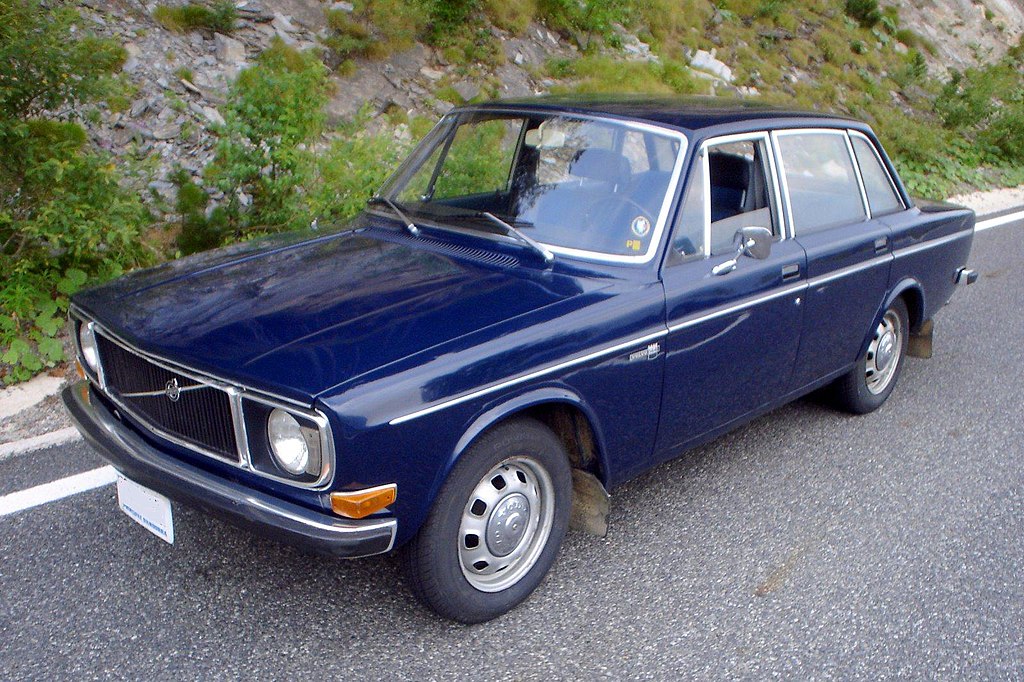 © Wikimedia.org/Noesveritat, CC BY
© Wikimedia.org/Noesveritat, CC BY
The Volvo 164 is a 4-door, 6-cylinder luxury sedan unveiled by Volvo at the Paris Motor Show early in October 1968 and first sold as a 1969 model. 46,008 164s were built before the car was succeeded by the 264 in 1975. The 164 was Volvo's first venture into the luxury segment since the end of PV 60 production in 1950, and was the first six-cylinder Volvo since the PV800 last produced in 1958. In 1968 Volvo introduced the 164 as a luxury version of their 140 series. The wings, the grille, the front bumper, the bonnet, the headlamp bezels, and the front indicators were all unique to the 164; to accommodate the long 3-litre 6-cylinder engine the 164's wings and bonnet were longer than those of the 4-cylinder 140, but the overall height and width of the 164 were the same as the 140 series. The interior featured a simulated woodgrain dashboard face and leather seating surfaces. Introduced the same year as the BMW E3, the 164 was Volvo's answer to the Mercedes-Benz 250 and Jaguar XJ6. The 164 compared favourably in terms of fuel economy with similarly sized 6-cylinder European cars such as the BMW 530. (Source: Wikipedia.org, CC BY-SA)
The Volvo 200 Series (or 240 and 260 Series) is a range of mid-size cars produced by Swedish company Volvo Cars from 1974 until 1993, with more than 2.8 million total units sold worldwide. Like the Volvo 140 Series (1966 to 1974), from which it was developed, it was designed by Jan Wilsgaard. The series overlapped production of the Volvo 700 Series (1982 to 1992). As the 240 Series remained popular, only the 260 Series was displaced by the 700 Series, which Volvo marketed alongside the 240 for another decade. The 700 was replaced by the 900 Series in 1992, a year before the 240 was discontinued. Production of the 240 ended on 14 May 1993, after nearly 20 years. (Source: Wikipedia.org, CC BY-SA)
The Volvo 300 Series is a rear-wheel-drive small family car sold from 1976 to 1991, both as a hatchback and (from 1984) as a conventional notchback saloon. It was launched in the Netherlands shortly after Volvo acquired a major stake in the passenger car division of DAF in 1973. The series consisted of the Volvo 340 (previously 343/345) and the later Volvo 360. After building a series of compact cars, DAF sought a partner to bring its new larger model, codenamed P900, and intended to become the DAF 77, to market in 1970. Several manufacturers were approached, including Audi, BMW, and Volvo. Volvo was not originally interested due to the cost, but they were later persuaded by DAF's access to Renault engines. This helped Volvo expand its model line-up without the large expenditures associated with developing a new model. Building cars in the Netherlands also helped the Swedish Volvo to access the markets of the EEC, of which Sweden was then not yet a member. (Source: Wikipedia.org, CC BY-SA)
The Volvo 700 series is a range of executive cars produced by the Swedish manufacturer Volvo Cars from 1982 to 1992. The 700 series was introduced in 1982 with the luxurious 760, followed two years later by the lower priced 740 which capitalized on the prestige attained by the very similar 760. The 700 series was then gradually replaced, beginning in 1990, by the 900 series. The 700, designed by Jan Wilsgaard, was originally to have been a replacement for the 200 series, but production of that model continued until the early nineties. The expensive 780, a Bertone-designed coupé version, entered production in 1986 and departed without a direct successor only four years later. (Source: Wikipedia.org, CC BY-SA)
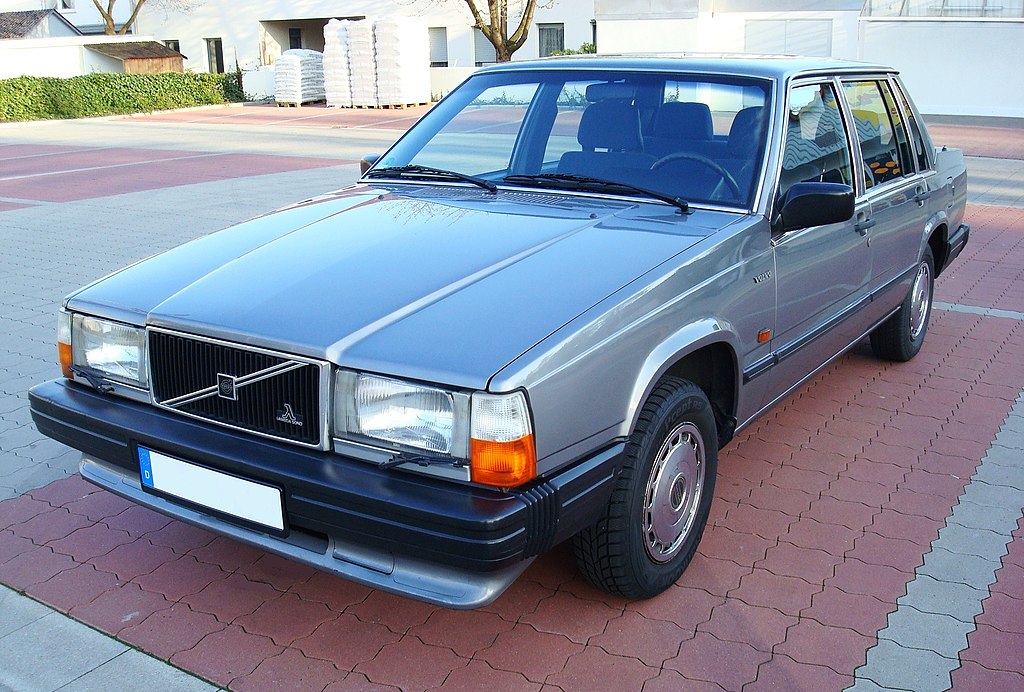 © Wikimedia.org/VonNortheim, CC BY-SA
© Wikimedia.org/VonNortheim, CC BY-SA
The Volvo 850 is a compact executive car that was produced by the Swedish manufacturer Volvo Cars from 1991 until 1996. Designed by Jan Wilsgaard, the car was introduced in a saloon body style; an estate style was introduced in 1993. The Volvo 850 was shown for the first time in June 1991, and the car marked a departure for Volvo, featuring multiple unprecedented features for the company; these included a transverse 5-cylinder engine driving the front wheels, a Delta-link rear axle, a side impact protection system, and a self-adjusting front seat belt mechanism. (Source: Wikipedia.org, CC BY-SA)

Time for recess! Post a comment, ask a question or write a review. Feel free to let us know what you think!
Most problems are a result of higher than safe driving speeds. Please just slow down and be patient.
Question 121: Poor translation: Vehicles with polluted fluids prohibited Should be translated as: Vehicles with dangerous liquids prohibited
Question 83: Poor translation: Vehicles with polluted fluids prohibited Should be translated as: Vehicles with dangerous liquids prohibited
Want even more practice? Visit similar websites offering realistic practice driving knowledge tests. Visit us to see what sets our tests apart! https://dkttest.com/capital-territory/
Cool tool! And fun to check whether I remember the rules :) Two things I noticed: Warning for a crossroad side roads on the left and right. While technically that might be the correct translation, this sign tells you, that you are on the main road and have the right of way for the next crossroad and only the next crossroad. Usually (if no sign specifies otherwise) you have to give way to drivers coming from the right at every intersection, which can get a bit annoying in communal areas, so seeing this sign feels less like a warning and more like relief :). A Fahrradstraße is not a lane for cyclists but a street for cyclists, meaning the (whole!) street is intended predominantly for cyclists, who are then allowed to ride next to each other. Cars are allowed to drive there (unless another sign prohibits such), but have to adjust their speed to the cyclists. I believe they are not allowed to pass at all, even if the oncoming lane is empty.
this website is a simpy website i love this its fat and im in my mums basement rn help sui u r a mothr fker
Hi i am such fat fan of this great gaming website. Im so hangry for the cause mate! Liking the simps eating on yall tho nott gonna lie to ya!
The system is now changed and they use some type of tablet for the exam now. Do anyone have the questions which they ask in the tablet because the questions are different. I still didn’t pass my provisional driving knowledge test. It would be great if someone could help
Good exercise !! Looking for some drift friends, hit to my email Funnyparts@gmail.com
More community